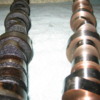Posted October 15, 2005 11:02 PM
George,
I would be honoured to hear you opinion, comments and advice on building a short block. The criteria being a street/performance engine. What about a stroker/forged crank etc.?
Why hydraulic roller lifters?
What is you recommendation for alluminum heads for a street performance motor? or is it better to stick with a built up stock (iron) 4V Closed Chamber heads. I would rather stick with my engine under the engine cover so, a dual plane manifold with Holley carb is what I would lean to. What do you recommend here?
Finally, is there a "trouble free" EFI system that fits under the engine cover you would recommend.
Thanks
B. Goyaniuk
Mr. Goyaniuk, I hope you don't mind, I started a new topic in which to discuss your questions, rather than "hi-jack" Kevin G's topic. You've asked a lot of questions, I will keep my answers short, and you can ask for more detail / clarification one at a time.
1. What about a stroker/forged crank etc.?
Because of the relatively inexpensive crankshaft cores produced in China, stroking a motor has become the best way to increase the output of a "street" motor, a motor that is used for non competitve applications, like city driving & open road traveling. This is so because it does not involve higher rpm or taking up additional room in an engine bay, drivability of the motor is actually improved. There is a second benefit in stroking the Cleveland motor, the increased displacement improves throttle response of the big port 4V heads.
2. Why hydraulic roller lifters?
In the attached picture at the bottom of this post, the cam on the left is a flat tappet camshaft, the cam on the right is a roller cam. Looking at the lobes in the middle of the frame, the lobe of the flat tappet cam has more of a "pointed" shape, the lobe of the roller cam is more blunt. The ramps of the roller cam appear almost verticle, those of the flat tappet cam are less steep, perhaps about 60 degrees from horizontal in the picture.
A roller cam lifts a valve open quicker, holds it at maximum lift longer and then closes the valve quicker. The maximum lift achievable within a certain lobe pattern is greater. More lift, held at max lift longer, without a long duration profile & without excessive overlap, makes more power for a street engine. It is the aggressive profiles of the roller cam that has enabled the incredible horsepower being made these days with push rod OHV V8 engines. The higher valve lift offers a second benefilt with the Cleveland engine, just like a "stroker" crank, that of improving throttle response when running the big port 4V heads.
I always specify a hydraulic lifters because adjusting valve lash is a hot & messy job, made even more difficult in the Pantera's engine bay. I do not believe mechanical lifters are warranted unless an owner is a masochist, or unless the car is being used in competition where a cash purse is involved.
3. What is you recommendation for alluminum heads for a street performance motor? or is it better to stick with a built up stock (iron) 4V Closed Chamber heads.
I covered this issue fairly well in Kevin G's topic regarding AFD heads. Due to the cost of preparing a set of iron heads for performance usage, the alloy heads look like a wise chioce to me, unless an owner wants to keep the motor looking "stock". The alloy heads won't make "more" peak torque necessarily, but they will make more torque at lower rpm, over a wider powerband, and improve throttle response.
For a standard displacement motor, the AFD 2V, CHI 2V & CHI 183cc 3V heads are the candidates. For a stroker motor The AFD 2V, CHI 2V & CHI 218cc 3V heads are the candidates. If there is a specific 4V intake manifold an owner wants to utilize, such as the Blue Thunder or Holley Strip Dominator, the CHI 4V head will be the only alloy choice. The performance of the CHI 4V head is very close to their 218cc 3V head.
4. I would rather stick with my engine under the engine cover so, a dual plane manifold with Holley carb is what I would lean to. What do you recommend here?
For a 2V head, the new Edelbrock performer RPM air gap manifold looks like the new hot ticket. For a 4V head, the Blue Thunder is the king of the 2 plane intake manifolds, and has been for about 25 years. For CHI's 3V head, the choice will be either Edelbrock's air gap manifold with spacers provided by CHI OR the new 2 plane manifold CHI has developed for their 3V head.
5. Finally, is there a "trouble free" EFI system that fits under the engine cover you would recommend.
For trouble free operation, I suggest an EFI system based on Ford's EEC IV, mass air flow FI system. Trick flow is developing a FI manifold for 2V heads, similar to that "manufactured" by Thomas Tornblom:
http://www.detomaso.nu/~thomast/efi/
Another approach is to replace the carburetor with a 4 hole throttle body, such as the system offered by quality roadsters:
http://www.qualityroadsters.com
That should give you something to think about for a while.
your friend on the PIBB, George
Attachments
Original Post



